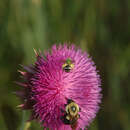fr
noms dans le fil d’Ariane


The Bombini are a tribe of large bristly apid bees which feed on pollen or nectar. Many species are social, forming nests of up to a few hundred individuals; other species, formerly classified as Psithyrus cuckoo bees, are brood parasites of nest-making species. The tribe contains a single living genus, Bombus, the bumblebees,[1] and some extinct genera such as Calyptapis and Oligobombus.[2] The tribe was described by Pierre André Latreille in 1802.
Bombus cerdanyensis was described from Late Miocene lacustrine beds of La Cerdanya, Spain in 2014.[3]
Calyptapis florissantensis was described by Theodore Dru Alison Cockerell in 1906 from the Chadronian (Eocene) lacustrine – large shale of Florissant in the US.[4][5]
Oligobombus cuspidatus was described by Antropov et al (2014) from the Late Eocene Insect Bed of the Bembridge Marls on the Isle of Wight, England. The holotype fossil was described by re-examining a specimen in the Smith Collection.[6][7]
The Bombini are a tribe of large bristly apid bees which feed on pollen or nectar. Many species are social, forming nests of up to a few hundred individuals; other species, formerly classified as Psithyrus cuckoo bees, are brood parasites of nest-making species. The tribe contains a single living genus, Bombus, the bumblebees, and some extinct genera such as Calyptapis and Oligobombus. The tribe was described by Pierre André Latreille in 1802.
Los abejorros (Bombini) son una tribu de la subfamilia Apinae. Es una tribu cosmopolita de ambos hemisferios. Habitan diversas altitudes, climas fríos, templados, semitemplados y cálidos.
Hay un solo género, Bombus Latreille (1802), los llamados abejorros, con más de 250 especies en 15 subgéneros. Se han descrito otros géneros fósiles.
Bombus cerdanyensis fue descrito del Mioceno tardío en lechos lacustres de Cerdaña, España en 2014.[1]
Calyptapis florissantensis fue descrito por Theodore Dru Alison Cockerell en 1906 del (Eoceno) lacustre – en lechos de Florissant en los Estados Unidos.[2][3]
Oligobombus cuspidatus fue descrito por Alexander V. Antropov en 2014 en un lecho del Eoceno de la Isla de Wight, Inglaterra.[4][5]
Los abejorros (Bombini) son una tribu de la subfamilia Apinae. Es una tribu cosmopolita de ambos hemisferios. Habitan diversas altitudes, climas fríos, templados, semitemplados y cálidos.
Hay un solo género, Bombus Latreille (1802), los llamados abejorros, con más de 250 especies en 15 subgéneros. Se han descrito otros géneros fósiles.
I Bombini Latreille, 1802 sono una tribù di imenotteri apoidei della famiglia Apidae.
In passato venivano considerati validi altri generi quali Bremus, Megabombus, Orientalibombus, Psithyrus oggi inclusi nel genere Bombus.